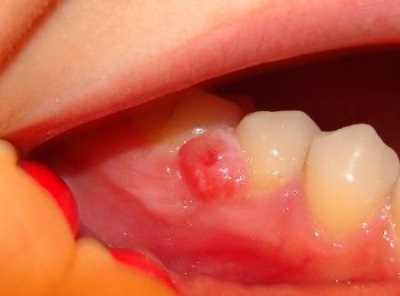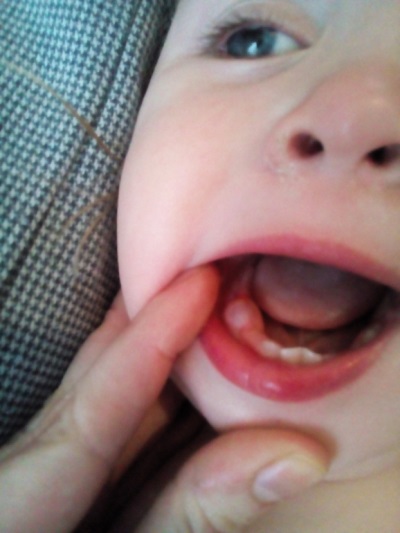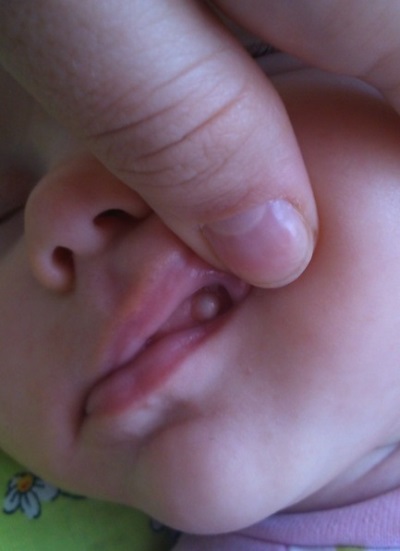Cyst on the gum in a child
Many adults know about the existence of such a disease as a cyst, but not all parents know that a cyst can appear on a child’s gum. Its danger lies in the asymptomatic course of the disease at first and the high risk of suppuration. That is why it is important to know how to identify a cyst on the gum in time and what to do when it is detected.
Causes of
A cyst inside the gum may appear due to:
- Caries, which passed into pulpitis and was not cured in time. If you ignore the presence of the disease, the bacteria penetrate the deep tissues of the tooth and form a cyst in the root area, filled with pus.
- Poor root canal filling. In a situation where the dentist did not completely close the canals with a filling material, there remains a reservoir with bacteria, which is the cause of the formation of a cyst and purulent inflammation.
- Perforation of the tooth during treatment. If the doctor accidentally damaged the canal wall, a cyst appears in this place, which can suppurate.
- Periodontitis. In this disease, the appearance of inflamed periodontal pockets is observed, and if it is impossible to remove pus from them, a cyst forms on the gum.
Symptoms
At the beginning of the development of a cyst, as a rule, the child will not have any signs of this process. Sometimes there is a slight swelling of the gums above the tooth, but there is no pain and the child does not pay attention to the swollen area of attention, so for the parents such manifestations go unnoticed. That is why in the early stages a cyst can be detected only during an examination at the dentist.
Over time, when the cyst grows and purulent inflammation develops inside, the child begins to feel discomfort and pain during chewing. Headaches, slight fever and general weakness are also possible. Sometimes the cyst enlarges so much that the child’s jaw swells up and the face looks asymmetrical.
Features in children
In childhood, a cyst is not always a pus-filled formation, and can sometimes appear in infants before teething, as well as in older children before the appearance of permanent teeth. It is represented by a bump, inside of which is a clear or bluish liquid. For white color, this formation is often called the "pearl cyst".
Such a cyst is a temporary phenomenon, usually it does not inflame, and does not hurt when pressed. In most cases, no treatment for such a cyst is required. If the formation causes discomfort in the crumbs, the dentist opens the cyst and releases the fluid contained in it, which also facilitates the eruption of the tooth.
Possible consequences
If you do not respond to the appearance of a cyst in a child on time, the following situations are possible:
- Pus from a cyst will burst out through the gum to form a fistula.
- The infection will spread to the lymph nodes of the jaw and cause their inflammation.
- Pus can get on the tonsils and cause chronic tonsillitis.
- Toxins from the formation will get into the blood of the child and will cause the development of allergies.
Treatment
The doctor’s tactics for a cyst in the gums is determined by the question - there is such a problem with milk teeth or with permanent ones.
- If the tooth is temporary and its root is affected by purulent inflammation, such a milk tooth must be removed.Similar surgical treatment is required to prevent infection of the germs of permanent teeth.
- If a cyst occurs at the root of a permanent tooth, its treatment is carried out as in adults. Sometimes the doctor performs hemisection, removing the cyst itself and the part of the tooth with the entire root, after which a crown is installed. In some cases, it is sufficient to perform a cystectomy, during which only a part of the root is removed with a cyst. With a very large cyst and a severely neglected disease, the tooth is removed, but in most cases they try to keep a permanent tooth.
Folk remedies can be used in the treatment of cysts only as an additional therapy after visiting the dentist.
To reduce inflammation and soreness, you can rinse your mouth with salted water, as well as infusions from sage, horsetail, calendula, chamomile, thyme and other medicinal herbs. In this case, all means for rinsing should be warm, and hot compresses with a cyst are unacceptable.















